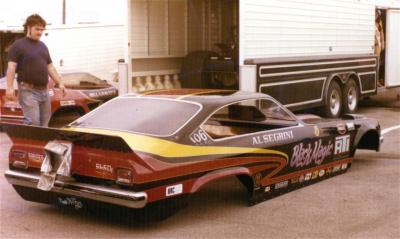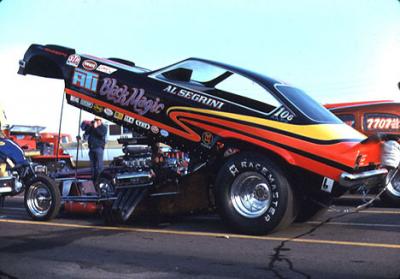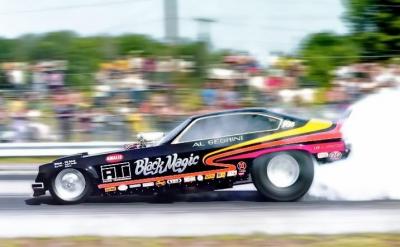-
Posts
4,582 -
Joined
-
Last visited
Content Type
Profiles
Forums
Events
Gallery
Posts posted by Force
-
-
Yes you are right, I was a bit hasty there...the 289 became available in the Falcon Sprint late 1964 and as an option engine for other models after that, 1963 and early 1964 the 260 was the only V8 option for Falcons.
But two Falcons with a 427 were made for racing purposes in 1964, one for Dick Brannan and one for Phil Bonner...and they were campained in the A/FX category and the match racing cirquit...but that's another story.
-
Pretty sure KFS http://www.kitformservices.com can help you with just about everything you need for those trucks.....
I know I'd like to grab one of those Long Line trans kits for one of my Scanias.....
And check for pics from those Jabbeke shows....Those boys build those things quite regular....
Yes KFS has most of the parts needed to do a similar truck and their stuff are very nice, but I think it will add up to about the same cost as the complete kit when you have bought everything and you still need to scratch build some stuff anyway.
But of course, if you can't get hold of the kit it's a way to do one.
-
Judging by the valve covers that's not an FE, but just a basic smallblock with dual quad carbs and an FE style aircleaner like on a shelby. Common practice back in the day. But it's definitely a 260 or a 289.
Yes it's most likely meant to be a 260 as the 289 wasn't available in the Falcon, but the people who did it from Trumpeter can not have seen a 221-302 small block Ford engine in real life because the kit engine is very oversize, a real 221-302 small block Ford is quite small compared to other V8 enignes...I have two of them myself, one 289 and one 302 based 347 stroker, so I have hands on experience of these engines.
The gearbox is another thing they can't have seen when they developed the kit, it looks like a weird combination of a C4 automatic and a manual transmission, the steering linkage looks a bit weird too, the real one doesn't really look like that.
But these are decent kits over all and all we have available to us at this time and your build will for sure be great Angel.
-
I have several K123s with the tortion bar suspension. I agree, they should be K125s. Im not sure when the change was made to the walking beams. As far as I can tell there was nothing box art related to tell the difference.
I haven't seen or found one yet but I know they exsist, as far as box art the same thing goes for the W925, all the later reissues has Walking Beam but on the earlier ones you can't see on the box wich suspension the kit has.
One can wonder why AMT gave the kit the K123 designation as it wasn't correct when the first tooling had the Torsion Bar...it is correct now tho', the W925 was correct at first but it became wrong when they changed to Walking Beam.
-
Yes the Ertl Transtar CO 4070A and the Transtar II has not been reissued under any other lable as far as I know, both has Detroit Diesel 8V-71 engines and the Transtar II was released in two versions, one with the same Air Ride as the 4070A and one with Walking Beam.
-
From what I remember,
All the Mack kits had the Mack camel back spring suspension. They also featured Mack engines and transmissions but I cannot remember if the AMT Cruise-liner and R model had the same engine and transmission?
The ERTL Macks actually had a semi-working camel back suspension on the DM600 and DM800 models and featured Mack's 5 x 3 transmission?
The Watkins W925 Kenworth had a NTA 370 Cummins with a Spicer 5 x 4 transmissions and Torsion Bar suspension.
The Original release of the "Movin On" Kenworth had the exact same specs as the Walkins Kenworth.
The Kenworth K123 had a NTA 370 Cummins with a Spicer 16 speed transmission and Henderson Walking Beam suspension.
The AMT Cruiseliner have a Mack ENDT-676 with the Tip Turbine air to air aftercooler and the R series from AMT.had a ENDT-675 without the aftercooler.
The Tip Turbine engine is supposed to be right for at least one of the Rubber Duck trucks from the movie Convoy, the sound was Detroit Diesel in the movie but the engine in one of the trucks must have been a Tip Turbine based on the dual intake air cleaner seen in several shots, this air cleaner was used on the Tip Turbine engines.
-
:lol:Its already been done just need to update and sort it all out...

Master list of kit info-
That's where I found some of the information for my lists in this thread...and I didn't take any credit for the legwork as most of it were done by someone else, among those you.

-
Both the Amt w900 and k100 had the torsion bar suspension. They both were changed to the Hendrickson walking beam with the release of the Kw/Challenge mixer kit. FYI the cabover Kw has Fuller road ranger tranny. The Watkins w900 and the Movin On truck are exactly the same kit with different box art and decals.
From what I have seen in the instructions for it on the modeltrucks25 Fotki site the AMT T559 Kenworth Challenge Transit Mixer kit still had the Torsion Bar Suspension, so the change must have been done sometime after that...I don't know when tho'.
I have not seen any Kenworth K123 kits with Torsion Bar suspension so far but then the kit should have had a K125 designation to be correct, the 123/923 is correct for the Walking Beam and the 125/925 was for the Torsion Bar.
just to let you all know www.jbot.com is no longer around
You can get Movin On decals from Modeltruckin'.
-
Of course you can leave the Cadillac engine in it if you want to, the Cadillac engine swap was so popular that Ford's and Mercury's with Cadillac engines were called "Fordillac" and "Mercillac"...and as Bill says, a stock early Cadillac OHV engine should be dark blue with white Cadillac scripts on the valve covers.
Ford themselves didn't switch over to OHV engines until 5 years later, 1954 with the 239 Y-block. -
If you want to swap out the Cadillac engine in the Revell Mercury kits the Flathead engine in the 48 Ford will not be correct, that engine is a 59AB and 1948 was the last year for that engine, the 1949 Mercury's and Ford's had the for 1949 new 8BA (Ford) and 8CM (Mercury) and that engine was available until 1953.
The most noticable differences are the placement of the distributor and the water outlets on the heads, passenger side front mounted angled distributor and front water outlets for the 8BA/CM, timing gear cover mounted distributor and center water outlets for the 59AB, both engine types had 24 head bolts, studs with nuts for the 59AB and bolts for the 8BA/CM.
If I would do a conversion I think I would take the engine and transmission from the AMT 49 Mercury as you get all necessary attachments such as correct air cleaner and other stuff.
The Mercury 8CM engine should be light green.
-
Nice Vette Alan.
-
Oh forgot about her...well she isn't really a regular so that's maybe why I didn't think of her.
I'm looking at live streaming of the Epping race right now as it's my only chance to follow NHRA drag racing nowadays.To go back to the old Enderle dual fuel pump plumbing here is a link to a build of Gary Ormsby's Dragster I did back in 1994.
http://www.modelcarsmag.com/forums/index.php?showtopic=91764&hl=
-
Isn't it the same Cummins NTA 370 engine as in the W-925 and T-600A kits, I believe the engine is the same in the W-925 kits with KW Torsion Bar and Hedricks Walking Beam so it could be the same for the K-123.
-
The Canopy developed by DSR a couple of years ago are used by the 3 DSR TF teams Tony Schumacher, Antron Brown and Spencer Massey, and the JFR team for Brittany Force...I don't think anyone else uses them right now...at least not in NHRA competition.
To make a current TF dragster from the latest developments of the Revell kits you need to change to a larger set back 14-71 blower, if your kit doesn't have the "big and ugly" carbon fibre injector hat (the Army and Bud King kits do) you'll have to change to one, then change or modify the valve covers to resemble the Titanium pieces with spark plug covers they use now, add a blower bag and hold down straps, change the fuel pumps to dual spur gear pumps, change the magnetos to MSD Pro Mag 44's, add a titanium shield to the roll cage behind the drivers head, update the oil catch can system, add a belly pan, change the rear wing to a 3 element, change the front wings to a full width in front of the nose cone, change the windshield to a larger one (or canopy), and change the wheels to a more current style.
-
Back in the day when the new style TF kits were originally made most nitro racers used dual Enderle gerotor fuel pumps and that's what Revell duplicated on their TF kits back in 1989-90 so back then they were correct.
Back then most teams used 2 barrel valves to get enough fuel into the engines, one on each side of the injector hat as the fuel flow wasn't enough in the old Enderle barrel valves to just use 1, one barrel valve was for feeding fuel to the lines under the injector hat and under the blower, and the other for the lines feeding fuel to the nozzles located in the intake port just behind the intake valves in the heads where most of the fuel are injected in a nitro engine so there were more lines distributing fuel back then than it is now.
Today they use only one larger metering valve (Pete Jackson) and the fuel systems has changed some since then and looks a bit different, still the same number of nozzles but less valves and fuel lines, and the newer fuel management setup can't easily be adapted to these older pump setups.
These Enderle fuel pumps was still there when Revell did the last updated TF dragster kits from 2002 with the Army and Bud King kits but all racers had changed to Sid Waterman "Bertha" series style dual spur gear pumps in the mid 90's as they gave more fuel flow per minute and higher fuel pressure than the Enderle pumps did, and that style pumps are still in use today on nitro engines.
If you look at the schematic picture above there are fuel valves on the return lines, that's correct and it's not a fuel log as they used several valves to regulate how much fuel is returned to the tank as they enrich the engine as the clutch engages and the engine RPM goes down, all this is actuated by timers and pneumatics.
Today most have replaced the multiple jet/timer system with a slide valve regulating the fuel curve.
Here is some good information explaining the fuel system on a Nitro engine.
http://www.darkside.ca/node/95
Revell never did enough updates to keep their Top Fuel Dragster kits up to current state over the years they were made.
It's not only the fuel pumps that has changed since these TF kits were developed, back in 1990 mostly all who raced Nitro engines used dual Mallory Super Mags and that's what's in the Revell TF kits, but in the mid to late 90's when most of the development of the Nitro cars took place all nitro teams changed to the larger better MSD Pro Mag 44's as they came available but they did never appear on the kits.
The blowers are larger 14-71's and set back, larger carbon fibre injector hats (often called big and ugly), 3 element rear wings, full width front wing and a some other things that Revell never did to their kits when they updated them (last was in 2002)....if they had they would still be pretty much up to date 13 years later as the cars looks nearly the same today as they did then.
-
Got my two sets in the mail the other day and they look nice and fits well.
-
The sadest part is that when they did the last issues they weren't exactly current either, these kits originally came out in the mid to late 80's and early 90's and was pretty much current when they were first released, the later issues were updated to a more current state but never enough to be "state of the art" at the time they were issued.
If Revell had done the necessary updates to the Top Fuel kits back in 2002 they would still be pretty much up to date today13 years later as the outside apperance hasn't changed much over these years, same for the Funny Car and Pro Stock kits except for the bodies of course. -
No current drag racing cars has been done lately, they have only done kits of older race cars and nostalgia race cars.
The last current Top Fuel Dragster kits were the Tony Schumacher Army Dragster and the Kenny Bernstein Budweiser King Dragster from 2002.
The latest current Funny Car kits were the Pontiac Firebird bodied kits from 1997-98.
And the latest current Pro Stock Car kits were the Warren Johnson Goodwrench and Mark Pawuk Summit Pontiac Firebirds from 1999 reissued in generic form by Model King in 2005-6...nothing current since then.
Revell has recently reissued a couple of the old Pro Stock cars from 1985-7 with the Reher-Morrison Camaro and Bob Glidden Motorcraft Thunderbird.
-
I remember and loved many of the Tom Daniels designed models from my yuth and I gladly built them as I thought they were cool, and I don't care much if the model is 1:24th or 1:25th scale, the difference is small and the subject is more important.
1:25th scale is mostly done by the US manufacturers, most others go for 1:24th scale like Tamiya, Aoshima, Fujimi, Italeri and several others. -
-
I finally managed to order a couple of sets May 28th and they're on the way, hopefully I'll get them next week.
-
Looks great Chris!!
-
Looking good Sean.
-
The biggest problem is to find a '68 Barracuda kit to build from, the AMT (ex MPC) Barracuda kit reissued several times in the last decades is a 69 and the old MPC 68 Barracuda annual kits are hard to find for reasonable money.
The 1968 is the only model year for this style Barracuda (together with the 68 Hemi Dart) classified for NHRA (and most others) Super Stock competition with the Hemi so the 69 will not work if you want to be correct as a 69 Hemi Barracuda never was built.
But there are some resin casters who does the 68 Barracuda or has a transkit with the front, the hood and rear panel to do a 68 from a 69 so all hope is not lost, but it would be great if Revell did a 68 Barracuda based on the 68 Hemi Dart kit as we need a better one than what's available to us at this point.




Hemi Question..
in Model Building Questions and Answers
Posted
I wouldn't worry too much about corrosion inside the chassis tubes, there is enough oil vapor in the crank case fumes to prevent that from ever happening.
The "puke" tanks got larger after the oil down penalty rules we have today came some years ago, they have to contain all oil from the engine if it blows up so the puke tanks got larger and more efficient, and the addition of full cover belly pans with capacity to contain all oil from the engine has minimized the oil spillage on the track....but sometimes it happens anyway.
Here are a couple of pictures of modern "puke" tanks.
First for a Nitro Funny Car
And a Top Fuel Dragster.